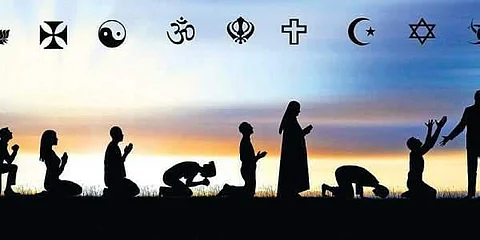

Facts defy some of our popular ideas. In the Sanskrit College of Kerala’s Tripunithura area, they had a senior lecturer in the Vedanta Department. Her name: Fatima Beevi. Tradition-bound minds were surprised, but Fatima saw nothing unusual in her taking up Upanishads as her research subject and finally getting her doctorate in Advaita Vedanta. Sister Lizi, an ordained nun from a convent in Kaladi, picked Arabic as her subject of specialisation. In her nun’s gown, she stood out among her purdah-wearing classmates. She was faster than others in learning Arabic and her recitation of the Bismillahi invocation won the admiration of all who heard it. In the colleges she worked in Malabar, P P Khadeeja became well-known as a Sanskrit teacher.
Her school-teacher father Moideen Kutty had encouraged her to learn the classical language. Her own children Aslam and Asma and Aisha learned Sanskrit even as they studied in the traditional Madrassa. If these were examples of the progressive mind at work, there were other cases that highlighted the opposite of enlightenment and tolerance. In 1999, newspapers published reports about a Muslim man in Tirur paying the price for his son Rasheed learning Kathakali. Rasheed had a gift for dancing and had won many prizes when he was in school.
He got admission to an institute teaching Kathakali and performed his arangetram in two years. Orthodox Islamic leaders in his native town raised objections. They told the boy’s father that his hotel business would have to be closed if he could not stop his son. The father lost his hotel and took to selling vegetables in a pushcart. Ironically, the family faced pressure from Hindu zealots as well. They wanted Rasheed to change his name to Ramayyan. Rasheed refused and had to face problems as a consequence.
Headlines were made in April 2000 when an Islamic scholar named Hassan Maulavi embraced Hinduism with the name Kamala Hassan. Comparisons were immediately made with the famous Malayalam-English writer Kamala Das, who went from Hinduism to Islam with the name Kamala Suraiya. The Maulavi, who was in close contact with the Shiv Sena in Kerala, had gone on record with objections to many Islamic practices. At one point, he had been attracted by the teachings of the Bible. He joined a Pentecostal mission institute for three years.
Eventually, he opted for Hinduism. He said he happened to read Ramayana and that was when his senses opened up to the intrinsic values of Hindu philosophy. From Ramayana he moved on to Vivekananda and eventually contacted Nitya Chaitanya Yeti, living then in Ooty. Yeti led him into the depths of Hindu thought, explaining the Vedas and the Upanishads. Every time Maulavi mentioned his idea of adopting Hinduism, Yeti would say such decisions must stem from one’s own independent thoughts and ideals. Invitations to attend the Maulavi’s conversion ceremony were sent out in the name of the Hindu Dharma Prachar Sabha. The situation produced some tensions and the Shiv Sena volunteered to provide full physical protection to the new Hindu.
Historical factors made religion integral to public affairs in India. Partition added a bleeding wound to it, with Hindu- Muslim antagonism leading to perennial problems. Today, with about 195 million Muslims constituting slightly more than 10 per cent of the country’s population, India is host to the world’s largest Muslim minority. In a more tolerant world, this would have been reason for happiness, if only because it means the blending of some of history’s richest traditions.
Time was when tolerance and co-existence were seen as signs of an enlightened mind. Iqbal once described Rama as the Imam of Hindustan, a beautiful phrase when we grasp its meaning. Many Muslim poets were inspired to write in the style of Chaitanya Mahaprabhu and the school of Vaishnava saints in general. Even today, pilgrims to Sabarimala pay obeisance at the shrine of Muslim saint, Vavar Sami. One-third of the proceeds from the Amarnath temple go to the family of Adam Malik, who discovered the cave hundreds of years ago.
Goga Merhi in Ganganagar, Rajasthan, is both a temple and a mosque. At Pirana, 18 kilometres from Ahmedabad, the shrine of Imamshah Baba is looked after by Hindu Patels. The Baba preached that the Prophet was an incarnation of Krishna. Meos of Bharatpur are Muslims who trace their descent from Arjuna and Bhima. There are many symbols of unity that bind India together. There are also many ways in which these symbols can be replaced with other emblems that guarantee disunity, intolerance and bigotry. The choice is ours.